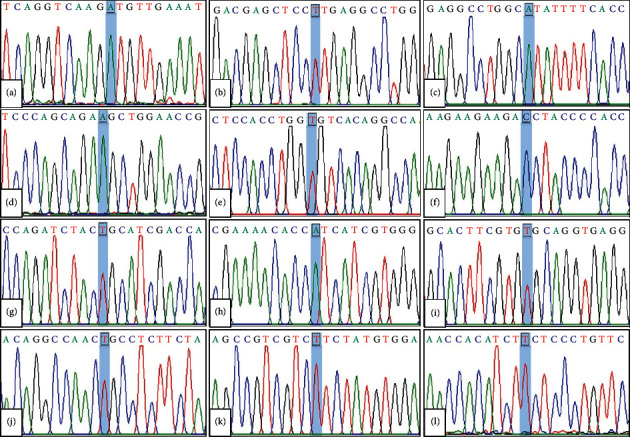泰国中部G6PD缺乏症儿童G6PD突变的基因型-表型相关性
IF 2.6
Q3 HEMATOLOGY
引用次数: 5
摘要
背景:葡萄糖-6-磷酸脱氢酶(G6PD)缺乏症是泰国最常见的x连锁遗传性红酶病。G6PD缺乏症的临床和血液学表现多种多样。目的:本研究旨在描述泰国中部三级医院Phramongkutklao医院随访的泰国儿科患者G6PD突变的基因型-表型相关性。材料和方法。本研究共纳入102例儿童,其中男性73例(71.6%),女性29例(28.4%)。突变分析通过G6PD基因所有编码外显子的直接DNA测序进行。91例(89.2%)出现新生儿高胆红素血症,11例(10.8%)出现新生儿期后急性溶血性贫血。结果:对102名G6PD缺陷泰国儿童的G6PD基因进行分子分析,鉴定出12种不同的突变。G6PD Viangchan (871G > A)和G6PD Canton (1376G > T)分别是男性和女性G6PD缺陷个体中最常见的突变(46.2%)和第二常见突变(15.4%)。所有受影响的男性G6PD突变为半合子,平均G6PD水平为16.7±11.5 (3-76)IU/ml。大多数女性患者(29例中27例,93.1%)G6PD突变为杂合子,平均G6PD水平为133.6±43.4 (9-195)IU/ml。2名女性患者(6.9%)突变为纯合子或复合杂合子,G6PD水平在男性范围内(35和10 IU/ml.RBC)。27例杂合子女性中仅有1例(3.7%)G6PD水平在男性(9 IU/ml.RBC)范围内,这可能与非随机x染色体失活有关。基因型、G6PD水平和临床表型之间的相关性在我们的研究中没有得到证实。在我们的研究中,所有纳入的G6PD缺陷患者都出现了新生儿高胆红素血症和急性溶血性贫血,因为基因型-表型相关性通常在慢性非球型溶血性贫血(CNSHA) G6PD缺陷个体中得到证实。结论:本研究揭示了导致泰国儿童G6PD缺乏症的G6PD变异的分子异质性。我们的研究证明了直接DNA测序的效率,可以在泰国儿童中识别出12种错义突变。本文章由计算机程序翻译,如有差异,请以英文原文为准。

Genotype-Phenotype Correlation of G6PD Mutations among Central Thai Children with G6PD Deficiency.
Background Glucose-6-phosphate dehydrogenase (G6PD) deficiency is the most common X-linked inherited erythroenzymopathy in Thailand. The clinical and hematological manifestations of G6PD deficiency are variable. Objective This study aimed to characterize the genotype-phenotype correlation of G6PD mutations in Thai pediatric patients who were followed-up in Phramongkutklao Hospital, a tertiary center in central Thailand. Material and Method. A total of 102 children including 73 males (71.6%) and 29 females (28.4%) were included in our study. Mutation analysis was performed by direct DNA sequencing of all coding exons of the G6PD gene. Ninety-one patients (89.2%) were presented with neonatal hyperbilirubinemia and 11 patients (10.8%) were presented with acute hemolytic anemia beyond the neonatal period. Results Molecular analysis of the G6PD gene in 102 G6PD-deficient Thai children identified 12 different mutations. G6PD Viangchan (871G > A) and G6PD Canton (1376G > T) were the first (46.2%) and the second (15.4%) most common identified mutations among both male and female G6PD-deficient individuals, respectively. All affected males were hemizygous for G6PD mutations and had an average G6PD level of 16.7 ± 11.5 (3–76) IU/ml.RBC. Majority of female patients (27 in 29, 93.1%) were heterozygous for G6PD mutations and had an average G6PD level of 133.6 ± 43.4 (9–195) IU/ml.RBC. Two female patients (6.9%) were either homozygous or compound heterozygous for the mutations and had G6PD level in the affected male range (35 and 10 IU/ml.RBC). Only 1 in 27 heterozygous females (3.7%) had G6PD level in the affected male range (9 IU/ml.RBC) which is possibly explained by nonrandom X-chromosome inactivation. The correlation of genotypes, G6PD levels, and clinical phenotypes was not demonstrated in our study in which all of the included G6PD-deficient patients were presented with neonatal hyperbilirubinemia and acute hemolytic anemia, since the genotype-phenotype correlation is normally demonstrated in chronic nonspherocytic hemolytic anemia (CNSHA) G6PD-deficient individuals. Conclusion This study characterizes the molecular heterogeneity of G6PD variants causing G6PD deficiency in Thai children. Our study demonstrated the efficiency of direct DNA sequencing which can identify 12 missense mutations in Thai children.
求助全文
通过发布文献求助,成功后即可免费获取论文全文。
去求助
来源期刊

Anemia
HEMATOLOGY-
CiteScore
4.80
自引率
3.40%
发文量
11
审稿时长
18 weeks
期刊介绍:
Anemia is a peer-reviewed, Open Access journal that publishes original research articles, review articles, and clinical studies on all types of anemia. Articles focusing on patient care, health systems, epidemiology, and animal models will be considered, among other relevant topics. Affecting roughly one third of the world’s population, anemia is a major public health concern. The journal aims to facilitate the exchange of research addressing global health and mortality relating to anemia and associated diseases.
 求助内容:
求助内容: 应助结果提醒方式:
应助结果提醒方式:


